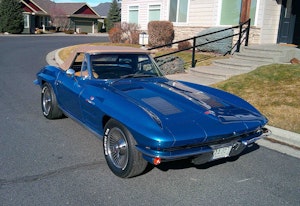Media | Articles
What’s driving today’s market? One answer: The cars
In the three decades I’ve been going to the Valley of the Sun in January for the collector car auctions there have been downs, ups and, in-betweens.
The week is known collectively as “Scottsdale,” even though the auctions have spread out from the putative center that is Barrett-Jackson at WestWorld. We now have auctions in Phoenix, Tempe, and Ft. McDowell as well as in Scottsdale proper.
Players, once just Barrett-Jackson and Kruse (remember them?) have, with the notable exception of B-J, come and gone. Russo and Steele again took a pass in 2022. Gooding & Company had a live preview of cars but sold them online. The Mitch Silver auction at Ft. McDowell has returned under new ownership, Motorsport Auction Group, “MAG Auctions”. Leake Auctions has disappeared.
Scottsdale is a valuable benchmark because it has such a long history. This week has always been the bellwether that collectors look to for indications of what is to come, of collectors’ attitudes and their liquidity and of the expectations of consignors.
Aside from the comings and goings of the auctions, 2022 marked the first Scottsdale after the isolation and redirection of COVID. We learned several things.
Marketplace
Buy and sell classics with confidence
First, people were just glad to be back. There was a palpable lightening of spirit. Yes, the chairs were farther apart but walk-in same day tickets to Barrett-Jackson still cost $90 on Friday and Saturday. Many of the spectators appeared to be eligible for reduced-rate “Senior” tickets. There were visibly fewer people, and the auction arena at B-J frequently had empty seats. The same could be said for RM Sotheby’s, Bonhams, and Worldwide.

It was “The right crowd and no crowding.”
B-J, RM Sotheby’s, Bonhams and Worldwide all were in their usual locations—WestWorld, Arizona Biltmore, Westin Kierland and Singh Meadows. Gooding & Company was different, holding a live preview of just 56 lots at the posh Hangar One at Scottsdale Airport and selling the cars on their Geared Online platform on Saturday, January 28.
The buzz was about high prices, but then in recent years the buzz has pretty much always been about high prices.
Much of the chatter came from people who hadn’t looked at the cars and didn’t know if they were spectacular or grimy. One expert held forth outside RM, lampooning the $110,000 hammer price DeLorean DMC-12. Indeed $110,000 for a DeLorean is a lot of money, but this was a 175-mile 5-speed still-in-the-wrapper DMC-12 with all its original documentation. Such a rare, pristine, original car has only a tenuous relationship to ”market” value and is no doubt worth much more than the typical DMC-12.

The best way to identify expensive, realistic, or good value cars is to compare those that have one or more prior sales at auction. There were 37 such cars in Scottsdale observed in detail and sold in the auctions. Their transactions’ outcomes were on average slightly above market. That is, in a nutshell, what the overall impression of the week’s prices were.
Other people groused about high prices in general.
The government and Federal Reserve have just put over $5 trillion Dollars into the U.S. economy over a period of less than two years. It has to go somewhere. Some of it, as we know from personal experience in December and January, went into driving up demand and prices of stuff we use, live in, and eat every day. But much of it is still liquidity, sloshing around in the bank accounts of carpenters, plumbers, accountants, and all manner of regular people. These are people who’ve put up with COVID for two years, who have had family members, friends, and neighbors die of COVID years before they should have.
Under those circumstances, when the money is there and mortality is a looming concern, there is a strong incentive to stand up and make another bid or two for a car you’ve always wanted so it can be enjoyed before the COVID bug bites.
And there were good values, more car and condition than the money they brought, like B-J’s Meyers Tow’d (the Meyers Manx’s short wheelbase brother) for $19,800 all-in, Bonhams’ Devin Super Sport Chevy for $95,200, Gooding’s 1913 White for $110,000 and RM’s Devin C (Corvair powered) for $78,400.
In 2020 the Scottsdale auctions sold 15 lots on hammer bids of over $1 million (excluding charity sales) and a total of $24,310,000. This year there were 23 million-dollar lots, for a total of $40,835,000. Ten of them were modern supercars built since the turn of the 21st century, like McLarens, Porsches and Ford GTs, delivery miles “instant collectibles.”

Conclusion? While prices were often generous, in many cases they were supported by the specific features of individual cars. There was a sea of humanity at RM, B-J, and Bonhams. Old cars sold well, running counter to the oft-repeated claim that new generations won’t appreciate cars older than they are. Even Fifties iron sold well, like B-J’s gorgeous ’57 Chevy Bel Air convertible that brought a curve-bending $143,000 all-in.
Of course there were irrationally expensive cars—probably bought by someone sitting out in the arena who hadn’t taken a close enough look. B-J’s Kaiser-Darrin was such, with a tacky, dirty recent repaint, good upholstery and a grubby engine compartment. It sold for an astounding $110,000 all-in. Mercedes-Benz 190SLs sold for grand numbers: One at RM and the other at B-J sold for $340,500 and $352,000 respectively. That is a pair of records set on consecutive days.
Yet viewed up close, Scottsdale was not a dramatic reset of the market. It was the market responding to supply and demand augmented by large amounts of liquidity, and a recognition that life does not go on indefinitely. There was a realization that the time to enjoy a classic car is now, not after you’re dead of a pandemic (or even endemic) virus.














